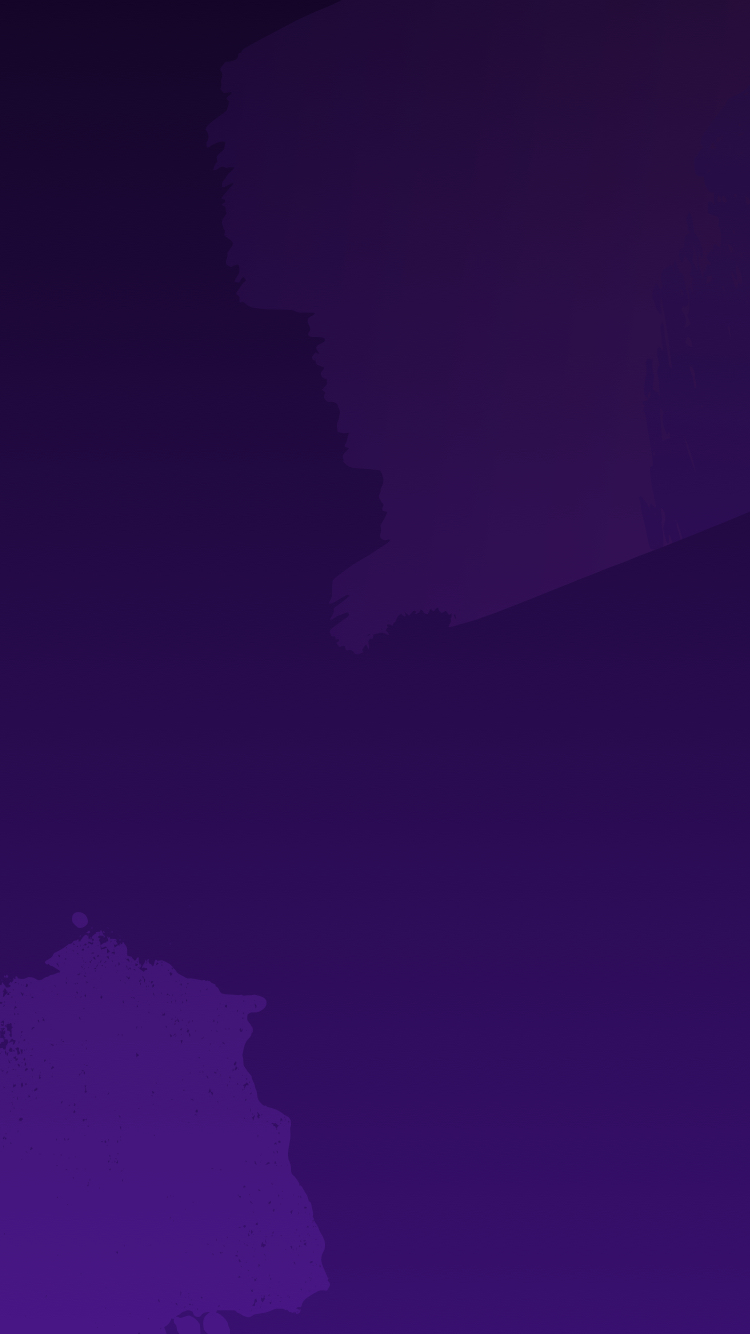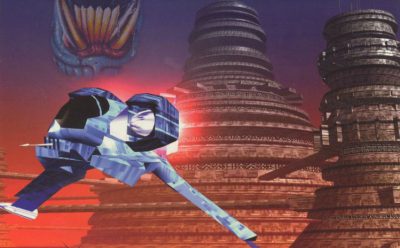Welcome to part three of our retrospective look back at the 100 games of Team17 – celebrating the release of PLANET ALPHA. In this instalment, we’re diving back to 1994 – a year in which we released not one but two Body Blows games, created the last ever 2D Alien Breed and went to a pub in Devon to record a game of pool! Read on to find out more…
Missed the previous chapters? Follow the links to read up on 1991/92 and 1993.
15/100
BODY BLOWS GALACTIC
Year: 1994 | Developer: Team17 | Publisher: Team17 | Format: Amiga
Team17’s second ever sequel after Alien Breed II, Body Blows Galactic was created with one goal, according to artist Danny Burke… “To do something different!” And so Body Blows blasted into space, leaving most of its earthly fighters behind and replacing them with interstellar pugilists like robots and dinosaurs. Danny and Junior (named after the game’s creators) still made the cut, but everything else was different, including six planet-themed backgrounds.
In retrospect, Body Blows Galactic was a great differentiator. Iterative fighting games were all the rage back then, with expanded versions of popular fighters increasing the number of backgrounds and the character roster, but Galactic also did this with a fresh new theme that was bolder than the average update.
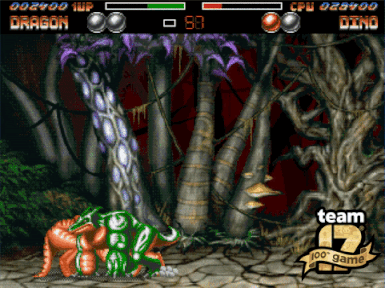
Like Alien Breed II before it, Body Blows Galactic came in standard and “AGA” editions, boasting graphical improvements and faster gameplay on the Amiga 1200/4000. This prettier edition reviewed better than the standard version but, overall, praise for Body Blows Galactic was rather mixed with the most detractors arguing that the new theme and characters didn’t present enough reason to upgrade from the original. Thankfully, players wouldn’t have to wait too long to get the ultimate version of Body Blows…
16/100
APACHE
Year: 1994 | Developer: Team17 | Publisher: Team17 | Format: Amiga
Anyone who bought a copy of Body Blows Galactic in 1994 may have noticed a sticker on the box, saying “Limited Offer – Free Game Enclosed”. Those lucky enough to pick-up this first print of the fighting game sequel, also found another disk inside… Apache!
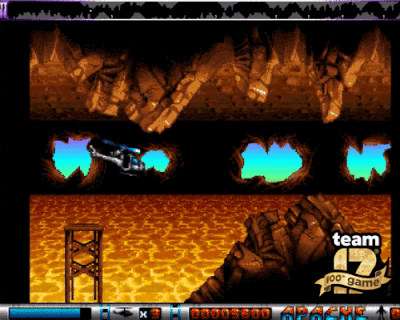
A side-scrolling shooter in which you piloted a helicopter, navigated caves and rescued diddy little people, Apache was actually the work of David Broadhurst and Haydn Dalton, the minds behind Assassin. “We started Apache with great intentions,” says Broadhurst, “but over time the ideas we thought were going to make the game great just didn’t come together as we hoped. We struggled for several months trying to find a good balance but just couldn’t get it into a state where we were happy. We had a game that was good but it needed to be great to release at full price so we decided to give it to players and let them give it a try.”
Apache was also given away with certain other Team17 releases, such as Alien Breed II, but never did receive a standalone release and remains one of the most obscure and forgotten games in T17 history. Good luck finding it!
17/100
ASSASSIN SPECIAL EDITION
Year: 1994 | Developer: Psionic Systems | Publisher: Team17 | Format: Amiga
If you’ve read about Alien Breed Special Edition or Project X Special Edition then you know the score by now. Our Amiga Special Editions took fan-favourite Team17 games, re-released them at a budget price, while also adding new content and improvements in response to fan feedback.
“In the case of Assassin,” says programmer David Broadhurst, “we got feedback that the game was hard to play, so it gave us a chance to smooth out some of the more difficult parts. We heard that some players found the first running jump hard to accomplish so it was removed. We generally did a pass over all the difficult areas and made them a bit easier to finish.”
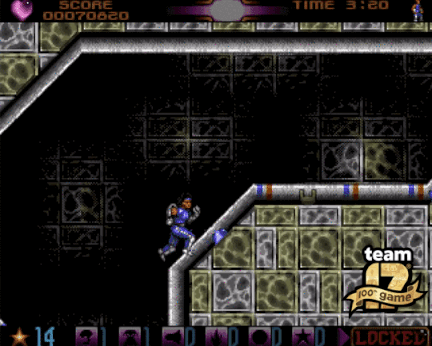
Gone was the opening forest section of the game and its pesky attack dogs, and in was a new opening mission set in a missile silo. This new opening to the game, really made use of the main character’s ninja-like abilities, with plenty of walls and ceilings for players to clamber up and hang from. Gone too was the main character’s boomerang weapon, instead replaced by a cool cybernetic arm that fired a laser. Most importantly, the large levels of the original game were broken up into much more manageable and smaller chapters, so players could get on with testing their skill, rather than their patience!
18/100
ARCADE POOL
Year: 1994 | Developer: Team17 | Publisher: Team17 | Format: Amiga, CD32, PC
Would you believe it if we told you that a very simple, budget pool game is actually one of the most popular games in our back catalogue and that we regularly receive requests for a remake? Well, it’s true! Arcade Pool was simple even by the standards of 1994, but sometimes it’s the simple games that are the most fun!
“Back in the early Nineties I felt that on Amiga there was no pool game like those previously available on Commodore 64, so I decided to do something similar,” says Mario Savoia, who handled both the programming and art on Arcade Pool.
Savoia was a dab hand at Amiga sports games, having developed 3D World series’ Soccer and Tennis games for Italian publisher Simulmondo, as well as classic car racing game 1000 Miglia for the same publisher. Arcade Pool was developed in Savoia’s spare time in-between these projects, and so he decided to offer it to other publishers. “Being a great fan of Team17 games, I thought it was worth trying to send it to them,” recalls Savoia. “I still remember the awe and happiness when I got a reply from Martyn Brown telling me they were interested in it and that we could work on it together.”
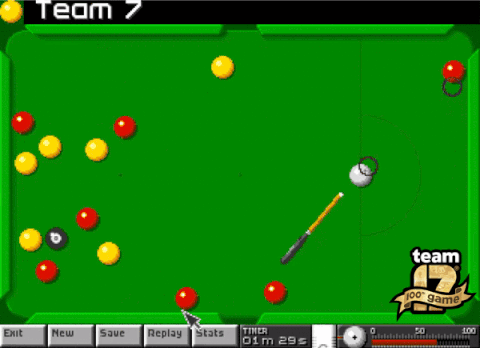
We totally meant to do that!
By 1994, the idea of creating a pool game in the style of a C64 release must have seemed rather quaint to some, and baffling to others. Three years earlier, the brilliantly talented Archer Maclean had created the incredibly impressive Jimmy White’s Whirlwind Snooker, featuring a full 3D simulation of the sport on the humble Amiga 500, but as a budget release, did it really matter if Arcade Pool was more primitive in scope? Not to Savoia…
“I didn’t care much about other pool games, b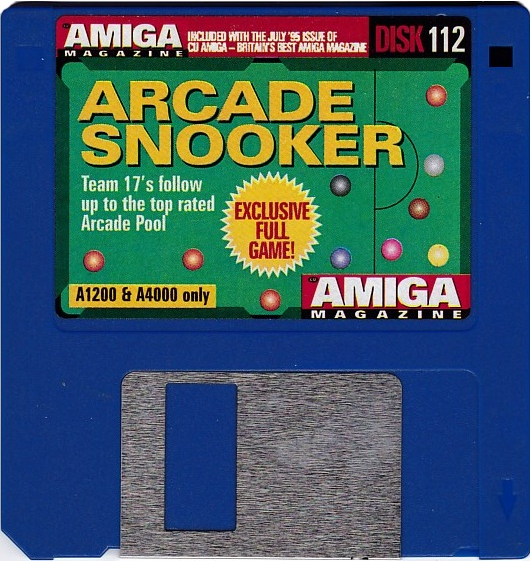 ecause I just wanted to make something fun and easy to play,” he tells us. “I was doing it mostly for me rather than the market.” So why did Arcade Pool resonate with so many other players? “I guess the key was the playability. Fun was preferred to appearance, and to keep the game small and fast on any Amiga. It makes me chuckle reading comment today from people saying how much they enjoyed playing it when they were kids.”
ecause I just wanted to make something fun and easy to play,” he tells us. “I was doing it mostly for me rather than the market.” So why did Arcade Pool resonate with so many other players? “I guess the key was the playability. Fun was preferred to appearance, and to keep the game small and fast on any Amiga. It makes me chuckle reading comment today from people saying how much they enjoyed playing it when they were kids.”
Though Savoia created the gameplay and graphics single-handedly, Team17’s star composer Allister Brimble, did chip in to provide the atmospheric sounds of Arcade Pool. “I created all of the sounds at my local pub in the middle of Devon. I used a tie pin microphone, as used by newsreaders and attached it with Blue Tack to the pockets,” says Brimble, proving that some aspects of the videogame creation process can be equal parts high tech and DIY ingenuity!
One bonus chapter in the Arcade Pool story came in 1995, when the game was adapted into Arcade Snooker (pictured right) for a CU Amiga magazine cover disk, converted from the original code by Savoia. “This was my last project on Amiga and it makes me a bit sad as it anticipated the sunset of a much beloved platform.”
19/100
ULTIMATE BODY BLOWS
Year: 1994 | Developer: Team17 | Publisher: Team17 | Format: CD32, PC
Buy: GOG.com
If Body Blows Galactic had kept all of the original Body Blows characters in addition to its new space age fighters, it would have taken up far too many floppy disks, artist Danny Burke tells us… “Disk swapping was not fun!”
So for the third and final entry in the series, we went CD-only, with Ultimate Body Blows destined to be Team17’s only Amiga game to remain exclusive to Commodore’s Amiga CD32 games console. The move to CD allowed the team to bring all 22 playable characters together in one game and made it possible to add in some amazing new background graphics that never would have fit on a floppy disk!
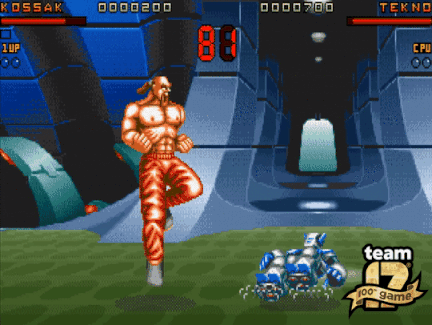
This “best of” remix went down a storm with reviewers. Amiga Power gave the game 86%, calling it “The best body Blows by a mile” while Amiga Format went one better (or four, depending on how you look at it) with a 90% review and the incredible quote: “Amiga’s best beat-em-up”.
20/100
APIDYA
Year: 1994 | Developer: Kaiko | Publisher: Team17 | Format: Amiga
Of Team17’s first 19 releases, all were either developed in-house or especially for Team17 as part of a publishing deal, but release 20 was a little different. This popular 2D shoot-em-up was originally published by Germany’s own Blue Byte Software in 1992 and subsequently licensed to Team17 for the budget re-release two years later. Why would we pick up someone else’s game? Because it was VERY good! Universally praised by critics on both its original and budget release, Apidya very much fit the “arcade on the Amiga” style we were aiming for in those early days.
Apidya’s programmer, Peter Thierolf, tells us how this original shooter, starring a bee, came to… er… be… “Apidya actually started out as a space shooter, codenamed Beyond The Planets when I was working on it as a sole developer. Luckily though, I was introduced to Frank Matzke who was doing art as a hobby at the time. He came up with the insect theme and provided all the great art. As far as I remember he had some biology book with great illustrations that made him aware of the theme.”
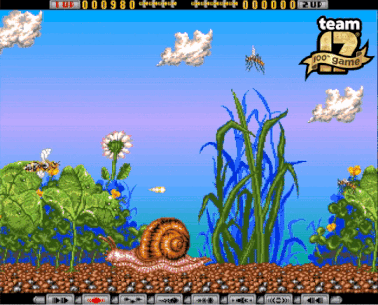
As well as the insect theme, Apidya had another overriding theme to it, although you might not be able to tell from the Team17 packaging. Look at the original Blue Byte release with its anime characters on the box and the katakana logo on the title screen, and it’s clear that the developers were going for a Japanese style too. “We were big fans of arcade games back in the day,” says Thierolf. “Many were graphically impressive and featured more polished game design than was seen on home computer games. We definitely tried to bring that kind of design and polish into our game. Frank also loved the design of Japanese games magazines so besides aligning the gameplay to arcade games he also brought up the idea of presenting the game as if it was done by a Japanese company.”
One of the most outlandish outcomes of the Japanese direction is also one that may have confused a few gamers back in the day – a roman numeral II after the title on the main menu. “The II was part of our strategy to look like a Japanese company,” Thierolf explains. “The idea was to tell the story that Apidya I was only published in Japan and this was the sequel. Well, we were young and a bit silly!”
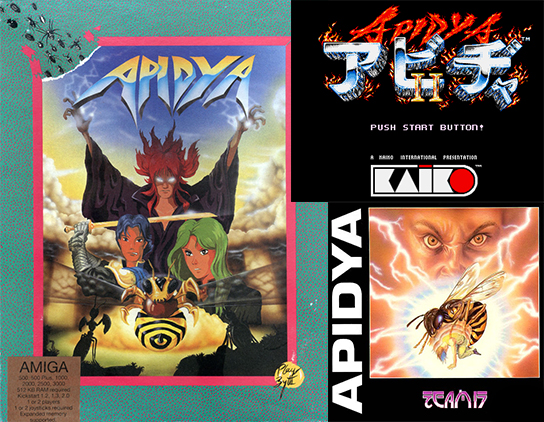
The original Blue Byte box art for Apidya, the in-game logo and Team17’s re-release packaging.
“Creating Apidya was a lot of fun even when it took us over two years,” Thierolf concludes. “It was my biggest work for Amiga at that point and I discovered a number of technical feats we could use to make the game shine. It was a time when you could invent new stuff that others probably didn’t think of yet. At the same time the game received very positive reviews, and is still listed as one of the best games of its genre on Amiga. All that still makes me proud all these years later.”
21/100
SUPER STARDUST
Year: 1994 | Developer: Bloodhouse | Publisher: Team17 | Format: Amiga, CD32, PC
Finnish developer Housemarque is very well known these days for their super high quality, arcade-inspired PlayStation games such as Nex Machina, Resogun and, er, Super Stardust HD. But did you know they originally got their start on Amiga? Back then Housemarque was actually two pre-merger studios: Terramarque, developer of acclaimed fighting game and Body Blows rival Elfmania, and Bloodhouse, creators of arcade shoot-em-up Stardust.
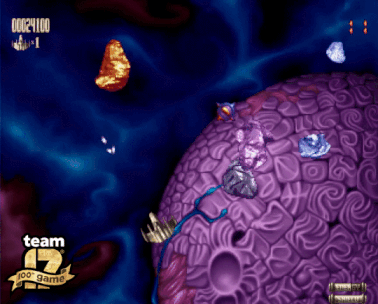
Though the original Stardust was self-published by Bloodhouse, the developers chose to go with Team17 for the sequel, which added stunning pre-rendered graphics to gameplay very much inspired by Atari’s Asteroids arcade game.
Showered with review scores of around 80-95%, Super Stardust was a bit of a corker. If you’d like to know how Housemarque cut their teeth and became the arcade masters they are today then look no further than Super Stardust!
22/100
ALIEN BREED: TOWER ASSAULT
Year: 1994 | Developer: Team17 | Publisher: Team17 | Format: Amiga, CD32, PC
Buy: GOG.com
The final Alien Breed to be released in the traditional 2D style, Tower Assault is arguably the defining game in the series. The original development team went all-out, building a non-linear adventure that right from the off allowed players to wander in any direction and enter various alien-infested towers, creating more than 250 different ways to complete the game!
“Alien Breed was already a great franchise, and Tower Assault was a fabulous addition to it; a superb game, with state-of-the-art graphics and fabulous level design, just fabulously playable,” says Marcus Dyson, a former Amiga Format editor, who later went on to work at Team17 and co-wrote Tower Assault’s story.
Among several new features, the ability to walk backwards and fire, called ‘retreat mode’, made a huge difference to Alien Breed’s run & gun gameplay, while the CD version of the game also came with a live action FMV intro sequence featuring some very impressive, for the time, 3D rendered space battles.
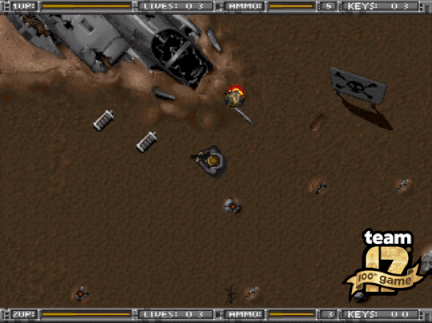
“The idea, like most ideas at Team17 in those days, come from a discussion in the pub,” remembers Dyson. “Tower Assault came at a time when other studios were branching into FMV, and the CD format was creating the technical environment that lent itself to larger and more ambitious intros. Cris Blyth and John Allardice, friends of mine from my Amiga Format days had both joined Team 17, bringing with them an amount of 3D, SFX and motion picture experience and enthusiasm that T17 hadn’t had in-house before.”
“John Allardice was an aspiring director,” explains Dyson when asked if the team had any filmmaking experience. “He’d done a pretty impressive showreel for a movie project, Wetware, that he was touting in 1992-93. We covered the shoot in Amiga Format, and I went along and did a little stunt work in it. That was how John and I became friends, and how he then came to work at Team17.”
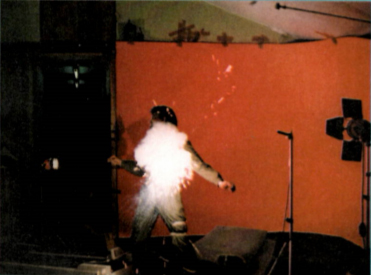
A Team17 staff member gets his five minutes of fame, at a cost, during the Tower Assault intro shoot.
“We shot the intro in the Team17 building! Our office at the time was on Garden Street in Wakefield. It was a decent sized space, and was used for warehousing, with the offices around the sides and above. We just cleared a space and used the central area.” And the actors? All Team17 staff! “I’m in it, almost everyone was. Lets face it, with Team17’s distributed development teams, and before the success of Worms, there were not that many of us at HQ. So if you were standing around the office, someone would thrust a helmet at you, and you would be thrown into a scene! The final result is both astonishing and embarrassing, like Babylon 5 starring the cast of Emmerdale!”
“Putting together that intro animation was just taking the ****!” Dyson exclaims. “We were a little Yorkshire software house saying c’mon Psygnosis, c’mon Hollywood, have some of this! I’ve always considered myself a punk, but the Tower Assault intro was one of the most punk things I’ve ever been involved with. A real creative, DIY thing.”
Check out the intro sequence to Alien Breed: Tower Assault in all its West Yorkshire Punk glory…
On that note, let’s conclude this look back at 1994. In the next instalment, we think we’ll cover… 1995! Discover Alien Breed taking the leap into 3D, more sports, more racing and a fairly successful game called Worms!
